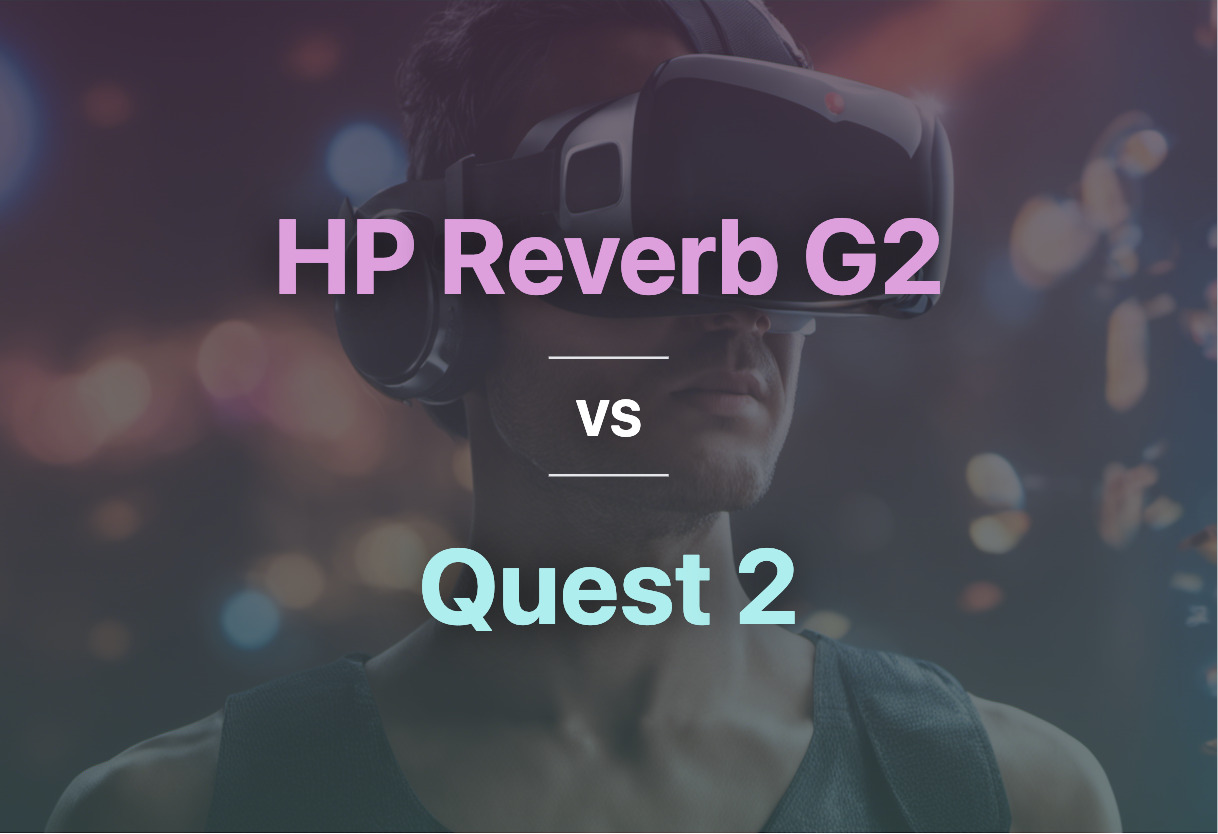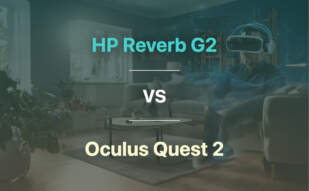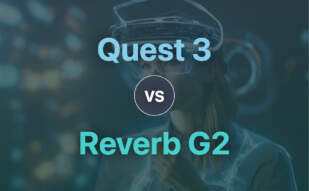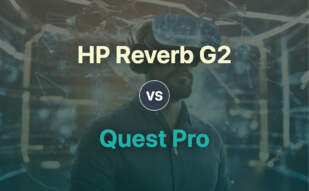For professionals seeking high-resolution experiences, the HP Reverb G2 offers superior pixel density and a robust $599 package. However, for the mass market, the Quest 2’s wireless, standalone functionality and cheaper $299 tag, combined with the ability to connect to a PC for enhanced experiences, makes it the most compelling choice.

Key Differences Between HP Reverb G2 and Meta Quest 2
- Price: The Reverb G2 is priced at $599, double the cost of the Quest 2 priced at $299.
- Pixel Density: The Reverb G2 offers a higher pixel density (2160 x 2160 px) than the Quest 2 (1832 x 1920 px).
- Wireless Capability: The Quest 2 can work standalone, while the Reverb G2 requires a PC connection.
- Compatibility: The Reverb G2 is primarily compatible with Windows 10 and SteamVR, while the Quest 2 has its own Quest Store with additional PC VR compatibility.
- Refresh Rate: Quest 2 operates at a higher refresh rate (120Hz) compared to Reverb G2’s 90 Hz.
- Tracking: Both use camera-based tracking, but Quest 2 also provides hand-tracking capabilities.
| Comparison | HP Reverb G2 | Meta Quest 2 |
|---|---|---|
| Price Point | $599 | $299 for 64 GB, $399 for 256 GB |
| Design | Four camera setup, memory foam-covered facemask, two speaker drivers, matte black plastic body, grey fabric padding | Lighter weight, four camera setup, updated Oculus Touch controllers |
| Resolution per Eye | 2,160 by 2,160 pixels | 1,832 by 1,920 pixels |
| Refresh Rate | 90 Hz | 72-120 Hz |
| Required System | Intel Core i5 CPU/AMD Ryzen 5 or above, Nvidia GeForce 1080/AMD Radeon 5700 or above, compatible with Windows 10 May 2019 update or later, DirectX 12 capable graphics | Qualcomm SnapDragon XR2 processor, 6 GB LPDDR4X memory |
| Connectivity | Requires DisplayPort and USB-C port | USB-C, Bluetooth 5, Wi-Fi 6 |
| Platform Compatibility | Windows Mixed Reality, SteamVR | Android-based Quest system software, Oculus Rift-compatible VR on a desktop computer |
What Is HP Reverb G2 and Who’s It For?
The HP Reverb G2 is a significant player in the VR headset landscape. It’s a consumer-bred VR headset, delivering immersive virtual experiences targeted towards professionals. Considered a successor to the original Reverb of 2019, the G2 squares up against heavy hitters such as HTC Vive Pro 2, Oculus Quest 2, and Valve Index. This headset is deployed to serve gamers and professionals looking for high-resolution visuals and capability to run various VR software.
Making use of LCD screens and a multi-cam setup for motion tracking, the Reverb G2 is a truth-bearing testament to HP’s commitment to improving user experience. With a price point of $599, it offers a high-value proposition for Windows 10 users seeking exceptional VR experiences.

Pros of HP Reverb G2
- High-resolution visuals
- Compatible with both SteamVR and Windows Mixed Reality platforms
- Camera-based motion tracking
- Comfortable fit with memory foam-covered facemask
Cons of HP Reverb G2
- Requires powerful hardware for optimal performance
- Limited to Windows 10 May 2019 update or later
- Occasional tracking hiccups can occur
- No finger-tracking capabilities
What Is Meta Quest 2 and Who’s It For?
The Meta Quest 2, initially launched as Oculus Quest 2, comes from the stables of Reality Labs, a division of Meta Platforms. The Quest 2 is aimed at users eager for a standalone VR experience.
With a competitive price point, the headset offers noteworthy features including high-resolution displays, long-lasting controllers, and the ability to operate both standalone and via a desktop. It’s a versatile headset suited for gaming enthusiasts and VR newbies who favor standalone capabilities with the option for PC connection.

Pros of Meta Quest 2
- Higher resolution and refresh rate
- Can operate either standalone or with a computer
- Extended store offerings with dozens of VR games and experiences
- Supports hand tracking
Cons of Meta Quest 2
- Short battery life – lasts only between 2-3 hours between charges
- No room for storage expansion beyond internal offerings
- Requires a Meta account for use
- Successor expected fall 2023 might reduce demand for the current model
HP Reverb G2 vs Quest 2: Pricing Overview
The HP Reverb G2 ($599) stands as a mid-range VR solution, priced under HTC Vive and Valve Index yet twice the cost of the competitively priced Quest 2 ($299-$399).
HP Reverb G2
With its base price set at $599, the HP Reverb G2 is positioned to compete with higher-priced VR headsets such as the HTC Vive Pro 2 ($799) and Valve Index ($999). However, it remains significantly pricier than the Oculus Quest 2 which is priced at $299. Interested users could avail a $200 discount with any device trade-ins. With impressive specs like high-resolution imaging and camera-based motion tracking, the HP Reverb G2 offers value for its price.
Quest 2
Costing $299 for 64GB and $399 for 256GB, the Quest 2 undercuts many of its competitors in price, including the HP Reverb G2. With the ability to operate standalone or with a desktop PC, an upgraded display, longer battery life, and compatibility with an expansive games and experience store, this headset provides a value-packed, versatile VR solution for its price category.
HP Reverb G2 vs Quest 2: Which Should You Lay Hands On?
The verdict lies right here. We delve deep into the specifics of HP Reverb G2 and Quest 2, examining the propositions that each brings to the spectrum of developers, AR/VR creators, game makers and tech enthusiasts.
Indie Game Developers
For independent game creators looking to develop immersive VR experiences without shelling out exorbitant amounts, the Quest 2 wins by miles. Why? Thanks to its sheer affordability, standalone nature, and compatibility with Android-based Quest system software. Ease of setup, user-friendly interface, and lighter weight promise a fluid development experience sans constraints of complex hardware setups.
Coding Bootcamps and Education Platform Providers
The HP Reverb G2 stands unbeaten for educational platforms seeking high-quality VR equipment. Its high-resolution display, four camera-based motion tracking, compatibility with both SteamVR and Windows Mixed Reality are massive points in its favor. Though pricier, the sharp imagery and room-sized VR capabilities make it a worthy investment.
Commercial Gaming Enterprises
Enterprise-level gaming companies, brace up for the HP Reverb G2. It combines professional-grade setup, stunning visuals, and multi-platform compatibility, making it the optimal choice. Despite the demand for PC power, the G2 offers the quality, detailing, and immersive experience that professional gaming environments require.
In the battle royale of HP Reverb G2 vs Quest 2, the G2 proves a stunner for professional use and complex applications, despite a higher price tag. Meanwhile, the Quest 2 emerges an obvious winner for individual developers and users favoring affordability and the standalone convenience.
Grant Sullivan
Content writer @ Aircada and self proclaimed board game strategist by day, AI developer by night.





